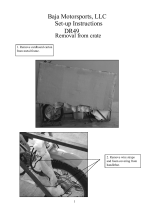PREPARA
TION 15
•
Attach a clear plastic hose to the bleed valve
on front master cylinder and run the other end
of the hose into a container.
•
With the reservoir cap off, slowly pump the
brake lever several times until no air bubbles
can be seen rising up through the fluid from
the holes at the bottom of the reservoir. This
bleeds the air from the brake master cylinder
end of the line.
•
Pump the brake lever a few times until it
becomes hard and then, holding the l ever
squeezed, quickly open (turn counterclock-
wise) and close the bleed valve. Then release
the lever. Repeat this operation until no more
air can be seen coming out into the plastic
hose.
A. Hold the brake lever applied.
B. Quickly open and close the bleed valve.
C. Release the brake lever.
•
Tighten the bleed valve to the specified
torque.
Torque: 5.9 N·m (0.60 kgf·m, 52 in·lb)
•
Attach a clear plastic hose to the bleed valve
on each front brake caliper and run the other
end of the hose into a container.
•
With the reservoir cap off, slowly pump the
brake lever several times until no air bubbles
can be seen rising up through the fluid from
the holes at the bottom of the reservoir. This
bleeds the air from the brake master cylinder
end of the line.
•
Pump the brake lever a few times until it
becomes hard and then, holding the l ever
squeezed, quickly open (turn counterclock-
wise) and close the bleed valve. Then release
the lever. Repeat this operation until no more
air can be seen coming out into the plastic
hose.
A. Hold the brake lever applied.
B. Quickly open and close the bleed valve.
C. Re
lease the brake lever.
•
Repeat the previous step one more time for
the other front disc brake.
•
When air bleeding is finished, check that the
fluid level is between the upper and lower
level lines.
•
Tighten the bleed valve(s) to the specified
torque.
Torque:
7.8 N·m (0.80 kgf·m, 69 in·lb)
•
Install the diaphragm and reservoir cap.
NOTE
○First, tighten the front brake fluid reservoir cap
clockwise by hand until slight resistance is felt
indicating that the cap is seated on the reser-
voir body, then tighten the cap an additional
1/6 turn while holding the brake fluid reservoir
body.
•
Apply the brake forcefully for a few seconds,
and check for fluid leakage around the fittings.
Rear Brake Fluid
Rear Brake Fluid Level Inspection
•
With the rear brake fluid reservoir held hor-
izontal, check that the fluid level is between
the upper and lower level lines.





















